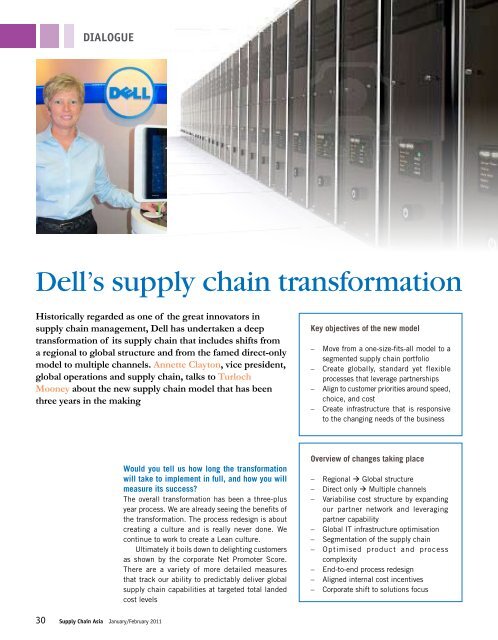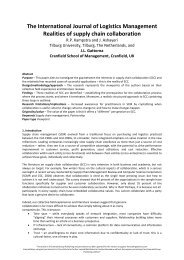Dell's supply chain transformation - John Gattorna
Dell's supply chain transformation - John Gattorna
Dell's supply chain transformation - John Gattorna
You also want an ePaper? Increase the reach of your titles
YUMPU automatically turns print PDFs into web optimized ePapers that Google loves.
dialogueDell’s <strong>supply</strong> <strong>chain</strong> <strong>transformation</strong>Historically regarded as one of the great innovators in<strong>supply</strong> <strong>chain</strong> management, Dell has undertaken a deep<strong>transformation</strong> of its <strong>supply</strong> <strong>chain</strong> that includes shifts froma regional to global structure and from the famed direct-onlymodel to multiple channels. Annette Clayton, vice president,global operations and <strong>supply</strong> <strong>chain</strong>, talks to TurlochMooney about the new <strong>supply</strong> <strong>chain</strong> model that has beenthree years in the makingKey objectives of the new model– Move from a one-size-fits-all model to asegmented <strong>supply</strong> <strong>chain</strong> portfolio– Create globally, standard yet flexibleprocesses that leverage partnerships– Align to customer priorities around speed,choice, and cost– Create infrastructure that is responsiveto the changing needs of the businessWould you tell us how long the <strong>transformation</strong>will take to implement in full, and how you willmeasure its success?The overall <strong>transformation</strong> has been a three-plusyear process. We are already seeing the benefits ofthe <strong>transformation</strong>. The process redesign is aboutcreating a culture and is really never done. Wecontinue to work to create a Lean culture.Ultimately it boils down to delighting customersas shown by the corporate Net Promoter Score.There are a variety of more detailed measuresthat track our ability to predictably deliver global<strong>supply</strong> <strong>chain</strong> capabilities at targeted total landedcost levelsOverview of changes taking place– Regional Global structure– Direct only Multiple channels– Variabilise cost structure by expandingour partner network and leveragingpartner capability– Global IT infrastructure optimisation– Segmentation of the <strong>supply</strong> <strong>chain</strong>– Optimised product and processcomplexity– End-to-end process redesign– Aligned internal cost incentives– Corporate shift to solutions focus30Supply Chain Asia January/February 2011
dialogue• Customers: With specific needs will choose configurableproducts Who want to use Dell as a trusted advisor willtend to choose pre-configured products Who value speed will choose from finishedgoods inventory or planned productionproducts and purchase them either director through the channel• Each <strong>supply</strong> <strong>chain</strong> will leverage the same globalpartner network, tools, and general processes.Targets for metrics will be different based onthe objective of the <strong>supply</strong> <strong>chain</strong>.What are the key challenges in overhauling your<strong>supply</strong> <strong>chain</strong> system in this manner and how areyou overcoming these challenges?Key challenges in this <strong>transformation</strong> includethe cross-functional and cross-organisationalnature of the change and the shift in skill set andculture required. We are tackling these throughstrong executive sponsorship, dedicated changemanagement, and cross-functional coordination toredesign processes end-to-end.How have the changes affected the organisationalstructure of Dell? How are they affecting your<strong>supply</strong> <strong>chain</strong> partners?As part of this <strong>transformation</strong>, Dell has transitionedfrom a regional structure to three global customerbusiness units – large enterprise, public, andconsumer/small & medium business. As part ofthe <strong>transformation</strong>, Dell’s <strong>supply</strong> <strong>chain</strong> investedin skill sets and capabilities. We created aroadmapping and phase review process to managechanges to the <strong>supply</strong> <strong>chain</strong>. As part of that wecreated a dedicated global <strong>supply</strong> <strong>chain</strong> strategyand enablement team. Additionally, we havedramatically changed how we interact with eachbusiness unit through our sales and operationsplanning <strong>transformation</strong>.Does the new model improve the CSR andsustainability capabilities of Dell? If so, in whatways?Dell is working to make ‘being green’ easy and costeffectivefor our customers. We offer free recyclingof PCs and related accessories to consumersworldwide.We have set goals to make our packagingsmaller and more recyclable. We are alsointroducing more sustainable packaging materialssuch as bamboo. We have reduced the energyconsumption of our desktops and laptops by 25percent since 2008. We source more than 25percent of our global electricity needs from clean,renewable energy.The structures that we put in place to managechange to <strong>supply</strong> <strong>chain</strong> capabilities will only helpus continue the focus and speed up responsivenessin this area.Dell is regarded as one of the great innovatorsin <strong>supply</strong> <strong>chain</strong> management. Do you think yournew <strong>supply</strong> <strong>chain</strong> model continues the traditionof <strong>supply</strong> <strong>chain</strong> innovation and if so, why?Absolutely, but in a different way. Dell wasoriginally heralded for creating a simple, powerfullyadvantaged model with just-in-time inventory andfull configurability. Supply <strong>chain</strong>s must supporttheir business strategy. Dell’s business hasdramatically changed in the last decade and willcontinue to do so; our <strong>supply</strong> <strong>chain</strong> will follow suitand evolve, too.Dell’s innovations going forward will be in thespeed at which our <strong>supply</strong> <strong>chain</strong> can adapt tochanging customer and business priorities.Would you provide some details on the currentstructure and make-up of your <strong>supply</strong> <strong>chain</strong>operations in Asia?Dell’s overall <strong>supply</strong> <strong>chain</strong> strategy is global. Aswith most of our industry, much of our $38bnin annual spend ultimately comes from Asia. Wecurrently have (including its ODMs) manufacturinglocations in multiple cities across Asia (Chennai,Penang, Shanghai, Xiamen, South China, Yantai,Taiyuan, and most recently announced Chengdu).We also use 12 distribution sites across the AsiaPacific and Japan region.How do you see this structure changing overthe coming years and what are the key factorsdriving this change?We are pleased with our global structure comingout of this change. The major factors drivingany future changes will be demographic shifts,macroeconomic considerations, and ultimatelywhat provides the best value and capability for ourcustomers.32Supply Chain Asia January/February 2011







